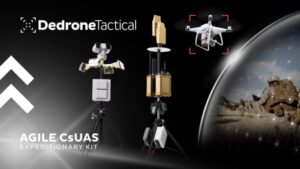


 Dedrone Announces Portable Counter Drone Solution
Dedrone Announces Portable Counter Drone Solution
by DRONELIFE Staff Writer Ian M. Crosby
Today, smart airspace security leader Dedrone announced the launch of its DedroneTactical agile CsUAS (counter small uncrewed aerial system) response kit, providing modular sensor-fusion and mitigation flexibility with Radio Frequency (RF) detect and defeat, in addition to camera and radar. All configurations utilize DedroneTracker.ai, an AI-driven autonomous command and control (C2) platform granting end-to-end CsUAS kill chain capabilities, allowing DedroneTactical to offer the most rapid and accurate CsUAS solution in any environment. So far, the company has sold over 100 DedroneTactical kits to US and global governments.
“The first half of 2023 has continued Dedrone’s incredible momentum from 2022, culminating in the new capabilities and equipment of our DedroneTactical solution, which were inspired by the demand of our federal customer base,” said Dedrone CEO Aaditya Devarakonda. “Through this multi-sensor detect and defeat solution, DedroneTactical delivers our advanced AI-driven sensor-fusion technology in an expeditionary format, enabling operators to make decisions quickly and more accurately. We look forward to continuing to innovate with, and in service of, all our federal customers and warfighters working to secure airspaces and protect people, property and information from the threat of drones.”
What’s in a Portable Counter Drone Solution?
DedroneTactical features two masted kits, a ruggedized laptop and associated peripherals, designed for toolless setup and tear-down in 15 minutes. DedroneTracker.ai enables the delivery of a comprehensive airspace security solution for use in any sUAS-based threat profile and location. With its true AI-driven sensor-fusion capabilities, DedroneTracker.ai conducts autonomous interrogation of potential threats to virtually eliminate false positives and deliver high threat score targets to the operator, resulting in quick and accurate responses.
“DedroneTactical was created in close collaboration with our most strategic federal customers to fill the current capability gap for a complete CsUAS kill-chain and support the requirements of the expeditionary warfighter in today’s Agile Combat Employment (ACE) mission,” said Dedrone Head of US Federal Business, Rob Campbell. “Dedrone continues to perform at the highest levels of efficacy at both Department of Defense and civilian test events. In fact, at our most recent review, DedroneTracker.ai’s AI-driven image recognition and autonomous detection engine performed at an estimated 95% accuracy level.”
DedroneTactical’s Base Kit supports various ruggedized RF sensors and BlueHalo Titan™ for EW defeat of RF-based sUAS across all protocols. Each of its sensors are mounted on a single tactical mast, and can incorporate additional remote DedroneSensors through wireless network links. The Extended Kit includes a second mast with radar and camera, allowing for non-RF drone detection for autonomously navigated drones as well as visual confirmation.
Read more:
Ian attended Dominican University of California, where he received a BA in English in 2019. With a lifelong passion for writing and storytelling and a keen interest in technology, he is now contributing to DroneLife as a staff writer.
Miriam McNabb is the Editor-in-Chief of DRONELIFE and CEO of JobForDrones, a professional drone services marketplace, and a fascinated observer of the emerging drone industry and the regulatory environment for drones. Miriam has penned over 3,000 articles focused on the commercial drone space and is an international speaker and recognized figure in the industry. Miriam has a degree from the University of Chicago and over 20 years of experience in high tech sales and marketing for new technologies.
For drone industry consulting or writing, Email Miriam.
TWITTER:@spaldingbarker
Subscribe to DroneLife here.





Related Posts
Blue Marble Shows How AI and LiDAR Deliver ROI for Rail Operators
First Breach and ideaForge Establish US Drone Manufacturing Partnership
Tennessee Drone and AAM Symposium Discusses Future of Mobility